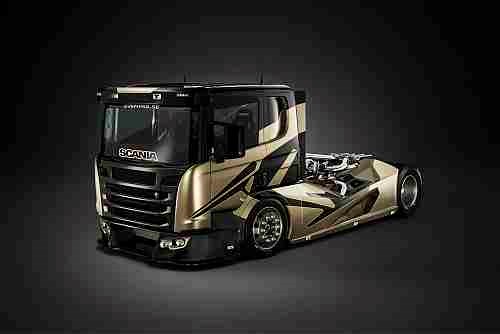Swedish show truck turns heads
Fifty-one years ago, Swedish car mechanic Sven-Erik Bergendahl, nicknamed Svempa, started his tow truck business with a 1957 Plymouth sedan that he transformed into a truck, and since then, Svempa has created eye-catching and souped-up tow vehicles for car and truck shows across Europe.

The Chimera show truck from Svempa and Scania is a hit at car shows in Europe.
Hot-rodding might have started in the US, but it has devout adherents around the world. Fifty-one years ago, Swedish car mechanic Sven-Erik Bergendahl, nicknamed Svempa, started his tow truck business with a 1957 Plymouth sedan that he transformed into a truck, and since then, Svempa has created eye-catching and souped-up tow vehicles for car and truck shows across Europe.
In mid 1980s, Svempa and designer Jan Richter started a partnership with Swedish truck and engine manufacturer Scania to produce modified Scania trucks for shows, and the results are highly-anticipated fan successes. A recent project, dubbed Chimera, may be Bergendahl’s and Richter’s most ambitious and complex yet. Begun in early 2010, Chimera took 4 years to complete, and involves considerable composite design and materials. Richter is a friend of Ragnar Friberg, who was the source of an earlier blog about a high-end champagne flute (http://www.compositesworld.com/blog/post/not-your-average-carbon-fiber-part) and who participated in the work. The Chimera project took more than 3000 hours from first design to finish, and the vehicle is continually being optimized, says Richter. “The truck consisted of a stainless steel tubular frame with attached truck cab, front and rear axles with 4 wheels, V8 Scania engine with power train, 6 turbos, radiators, intercoolers and exhaust piping,” explains Richter. “When planning the composite body we had to take into account the heat coming from the Scania turbo-charged 16-liter V8.”
Using Richter’s drawing, Svempa workers fabricated a cardboard mockup of the bodywork, to assess aerodynamics, overall appearance and the best approach for molding the parts. They came up with five composite sections: two would cover the left and right sides of the engine, between the front and rear wheels; two would cover the left and right (front) wheels, and connect with the fifth section, at the front of the cab.

Ragnar Friberg works on the foam core ribs that shaped the composite side skirts.
Detailed measurements were taken and a series of ribs were waterjet-cut from pieces of Divinycell, Matrix MX 7-7, 25mm thick, with a density 55Kg/m3, supplied by DIAB. Friberg then “dressed” the ribs with 10mm-thick core material (same density as the 25mm) and glued the pieces to the ribs with a 30-minute cure epoxy mixed with Wacker Aerosil as a filler, which, he says, made the foam structure durable and easy to grind to final shape.
Prior to lamination, the core material was covered with an epoxy putty mixed with a thixotrope, necessary, says Friberg, to prevent the foam core from absorbing any laminating resin and becoming too heavy. The sandwich skins, inner and outer, were created with one layer of 290-g/m, 2x2 E-glass twill supplied by Hexcel, followed by a second layer of 245-g/m, 2x2 3K carbon fiber twill from AKSACA, in a hand layup process that carefully ensured the material accommodated the bodywork curves. Epoxy resin, together with a hardener that provided a 90-minute outtime, was supplied by Nils Malmgren AB. Parts were oven-cured at 60°C for 10 hours.

A view of the carbon and glass laminate.
Composite part weights totaled 41.5 kg, saving 1,500 kg compared to a production Scania truck of the same size with a steel body. Says Richter, “About 1300 hours were spent to build the truck body, not counting the paint job, and total cost was about $800,000 USD.” He adds that the goal was a contemporary, even futuristic-looking, race truck, to complement Svempas’ earlier, retro-inspired Red Pearl show truck: “Our priority was really more to display the engineering and the powerful V8 engine and turbos. The biggest challenge was setting up the frame and suspension to handle the weight of the powertrain and unsprung parts.”
The truck has now appeared at several European truck events, with very positive fan love. There are many YouTube videos related to Svempa trucks, including the Chimera: https://www.youtube.com/watch?v=zUbo0wsruew and https://www.youtube.com/watch?v=e5uTmXz2VIs. This video features the more retro-inspired Red Pearl show truck: https://www.youtube.com/watch?v=2LzwCtm6JmQ. Check out this article about the Chimera, posted by Mack Trucks: http://www.bigmacktrucks.com/topic/36667-the-dream-truck-builder%E2%80%99s-latest-creation/.
Related Content
Combining multifunctional thermoplastic composites, additive manufacturing for next-gen airframe structures
The DOMMINIO project combines AFP with 3D printed gyroid cores, embedded SHM sensors and smart materials for induction-driven disassembly of parts at end of life.
Read MorePEEK vs. PEKK vs. PAEK and continuous compression molding
Suppliers of thermoplastics and carbon fiber chime in regarding PEEK vs. PEKK, and now PAEK, as well as in-situ consolidation — the supply chain for thermoplastic tape composites continues to evolve.
Read MoreSulapac introduces Sulapac Flow 1.7 to replace PLA, ABS and PP in FDM, FGF
Available as filament and granules for extrusion, new wood composite matches properties yet is compostable, eliminates microplastics and reduces carbon footprint.
Read MoreRecycling end-of-life composite parts: New methods, markets
From infrastructure solutions to consumer products, Polish recycler Anmet and Netherlands-based researchers are developing new methods for repurposing wind turbine blades and other composite parts.
Read MoreRead Next
All-recycled, needle-punched nonwoven CFRP slashes carbon footprint of Formula 2 seat
Dallara and Tenowo collaborate to produce a race-ready Formula 2 seat using recycled carbon fiber, reducing CO2 emissions by 97.5% compared to virgin materials.
Read MoreVIDEO: High-volume processing for fiberglass components
Cannon Ergos, a company specializing in high-ton presses and equipment for composites fabrication and plastics processing, displayed automotive and industrial components at CAMX 2024.
Read More“Structured air” TPS safeguards composite structures
Powered by an 85% air/15% pure polyimide aerogel, Blueshift’s novel material system protects structures during transient thermal events from -200°C to beyond 2400°C for rockets, battery boxes and more.
Read More






















